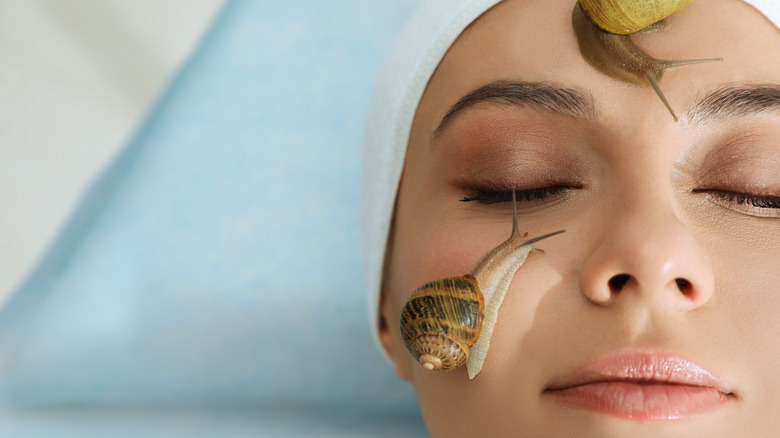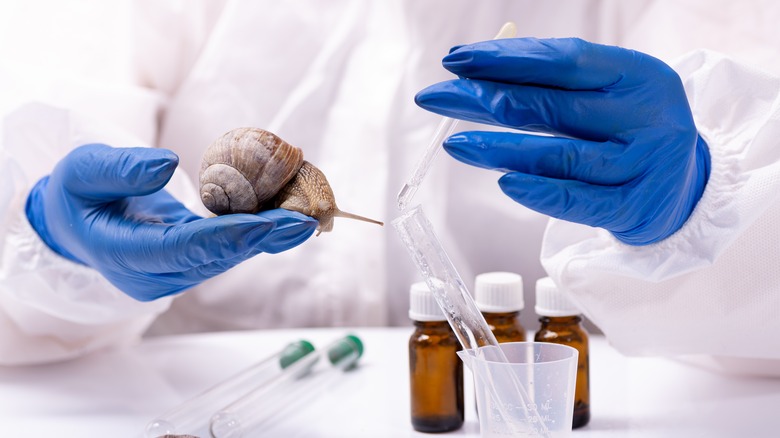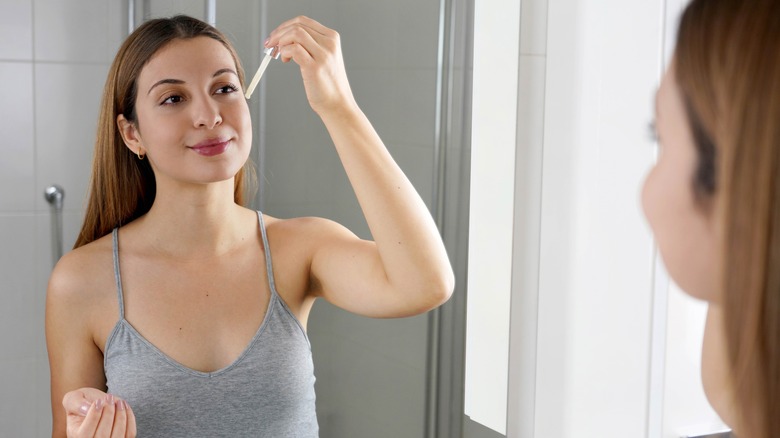Snail Mucin: Where Does The Product Fit In Your Skincare Routine?
The Korean beauty scene has been a leading global influence for the past decade, thanks to its innovative technology and formulations that are "about 10-12 years ahead of the rest of the world," Marie Claire's digital beauty editor Katie Thomas opined to the BBC. K-beauty's focus on using skincare as its foundation introduced us to the 10-step beauty routine, super dewy glass skin, and Korean sunscreen that's also skin-nourishing. Unconventional ingredients are used as well, including snail mucin, also known as snail slime or snail excretion.
Since the Korean brand, Missha, first introduced its Super Aqua Cell Renew Snail Cream, which claims to have 70% snail slime extract, the use of snail mucin has expanded to serums, face masks, and cleansers. There's even a snail slime-formulated shampoo. "This ingredient has become popular because it's an effective ingredient when it comes to anti-aging and minimizing acne scarring," Charlotte Cho, certified esthetician and the co-founder of online beauty marketplace Soko Glam explained to W Magazine. Although it is more than 90% water (per The Conversation), Byrdie lists the following as its components: allantoin, zinc, manganese, copper peptides, glycolic acid, and vitamins A and E. These ingredients help make snail mucin a "mega multi-tasker" that addresses various skin concerns.
Snail-mucin use is an age-old practice
To be clear, the use of snail slime for beauty and health purposes isn't a novelty, although Korean beauty brands certainly made it trendy. The practice dates back to ancient Greece when the Greek physician Hippocrates would reportedly use crushed snail shells to treat skin inflammation. Fast forward to 1980s Chile when the company Elicina developed a cream after workers on a snail farm had noticed how well the skin on their hands reacted to the constant contact with the mollusks. An Elicina representative told the Associated Press how the product proved "useful in cases of burns, minor cuts, stretch marks, acne, keloids ... Actually, what it does is regenerate skin."
For the snails themselves, their slime functions both as an adhesive and a form of defense. According to The Conversation, they produce it to create "a viscous environment" that prevents predators from breaching their shells. To trigger this defense mechanism, MasterClass revealed that commercial farms would agitate the snails, either by nudging them with something sharp or feeding them salt water. They then collect the slime to filtrate and purify it so it becomes a suitable ingredient for skincare products. Dermatologist Dr. Ted Lain told Byrdie that this harvesting process infuses snail mucin with the ingredients that contribute to its skin-repairing and protecting capacity. The Outline reported, however, that some companies have developed less invasive and damaging methods due to concerns about profitability and the ethical treatment of the mollusks.
An additional hydration step but not a replacement
Despite its popularity, some experts remain skeptical about snail mucin's efficacy, specifically when it comes to anti-aging. Plastic surgeon Dr. Matthew Schulman told The Cut that the ingredient can't smooth deep wrinkles, though it can improve skin texture. Another plastic surgeon, Dr. Joel Studin, told the publication, " ... [There] are no good studies that show it really works for anti-aging."
Dissenting opinions haven't lessened its hype, though. Last year, Coherent Market Insights valued the global snail beauty products market at $555.9 million, projecting its worth to reach $1.2 billion by 2030. Plus, just as skeptics point to the lack of long-term studies substantiating its benefits, enthusiasts cite the lack of documented side effects from snail-mucin use. Board-certified dermatologist Dr. Sheel Desai-Solomon advised being mindful of possible allergic reactions, per Byrdie. She recommended consulting with a dermatologist first before adding snail slime (or any new ingredient) to one's skincare routine and doing a skin patch test.
If you're curious to see how it works for your skin, start with a water-based snail mucin essence, as cosmetic chemist Georgia Smith suggested to Everyday Health, before leveling up to serums with their higher concentrations. Dermatologist Dr. Rosemarie Ingleton also advised via Elle to treat snail mucin as an additional step to skin hydration. "Put it on after your active products, like a vitamin C serum, and before your moisturizer." Do this during your evening routine so it works its regenerative powers overnight.


